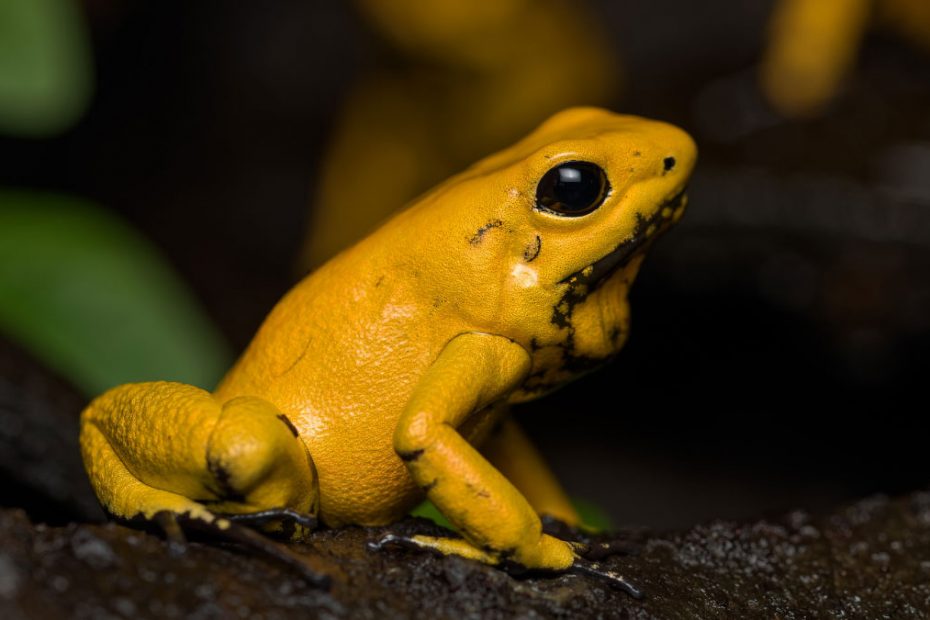The Golden poison dark frog is known for its poisonous skin excretion, which is potent enough to kill its predators as well as humans. It also goes by other names such as golden poison dart and golden poison arrow frog.
Golden poison dart is native to the rainforests of Colombia, South America. It get its name from local natives who would use its venom to poison their blowgun dart tips for hunting.
Despite what its name suggests, this frog isn’t truly golden. Instead, it comes in a variety of colorations, which vary from bright green to yellow or orange colors. However, juvenile frogs usually feature darker coloration and dual golden stripes on the neck area. An adult is approx. approx. 6cm long and weighs a mere 30 grams.
Whether you are a researcher, animal enthusiast, nature lover, or student, learning about this frog’s aspects like natural habitat, behavior, etc., is helpful for scientific research as well as conservational efforts.
In this article, we will cover more details about the golden poison dart frog including its behavior, physical characteristics, diet, predation, poisonous aspects, and other interesting facts about Golden Poison Dart Frog.
We will also discuss the current conservational status of this frog, various threats to its survival in the wild, and measures and initiatives put in place to help protect it.
Species name:
- Common names: Golden Poison Frog, Gold Poison Arrow Frog, Gold Poison Dart
- Scientific name: Phyllobates terribilis
Classification:
- Family: Dendrobatidae
- Genus: Phyllobates
- Species: Phyllobates terribilis
Physical Characteristics
The Golden poison dart frog is quite small; an adult is approx. 1 to 2 inches (or 2.5 to 5cm) long and weighs less than 30 grams (1 ounce). Females typically grow larger than males.
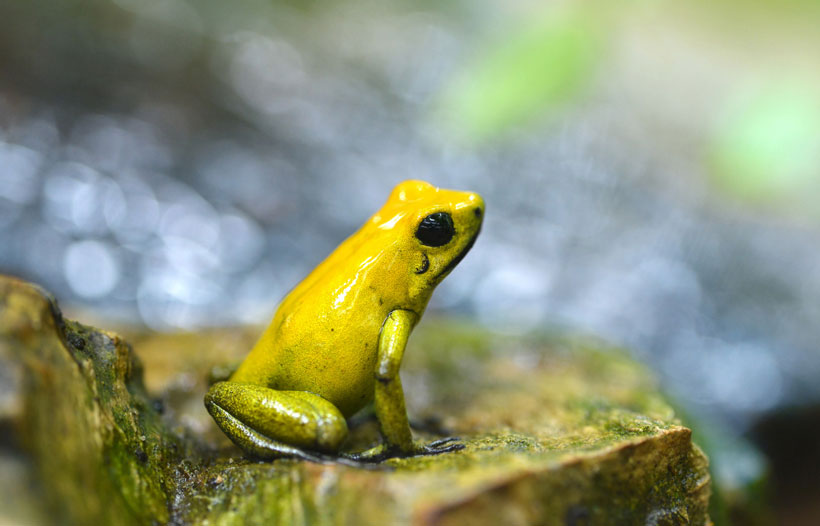
Coloration and markings:
Regarding skin coloration, adult golden poison dart frog is brightly colored. However, this color is not golden as its name suggests.
Instead, the coloration varies (usually geographically) from golden yellow to golden orange and pale green.
However, juvenile frogs usually feature darker skin coloration with dual golden-yellow stripes on their back.
This darker appearance fades as they mature into adulthood and they become fully brightly colored around the age of 18 weeks.
Unique adaptations:
- Bright-colored pattern: It helps keeps predators away by acting as an aposematic coloring—i.e., it warns a potential predator of its toxic nature. The predator may recognize the color as something that is non-palatable or not good tasting and decide to avoid it.
- Poisonous skin excretion: The skin usually contains powerful alkaloid venom, which can easily kill the frog’s predators. This poison is so strong that it can kill as many as 20,000 mice or 10 humans!
- Smooth and moist skin texture: This is another adaptation for the golden poison dart frog that makes it hard for predators to grasp the frog and hold onto it.
Natural Habitat
Golden poison dart frog is endemic to the rainforests of Colombia in South America. It prefers living on the forest floor of the tropical rainforest.
It’s mostly found in humid lowland forests near waterbodies such as streams, which is crucial for raising their young ones.
However, the distribution of this frog in the wild is limited to certain areas of Colombia—in Cauca Valley and Chocó region on the Pacific Coast.
What’s in the rainforest ecosystem?
Its natural habitat, the tropical rainforest ecosystem, is one of the most diverse on the planet.
It is characterized by high temperatures and rainfalls and is home to a wide variety of animals and plant species.
Examples of animals found in this ecosystem include a wide variety of amphibians, reptiles as well as monkeys, toucans, sloths, etc.
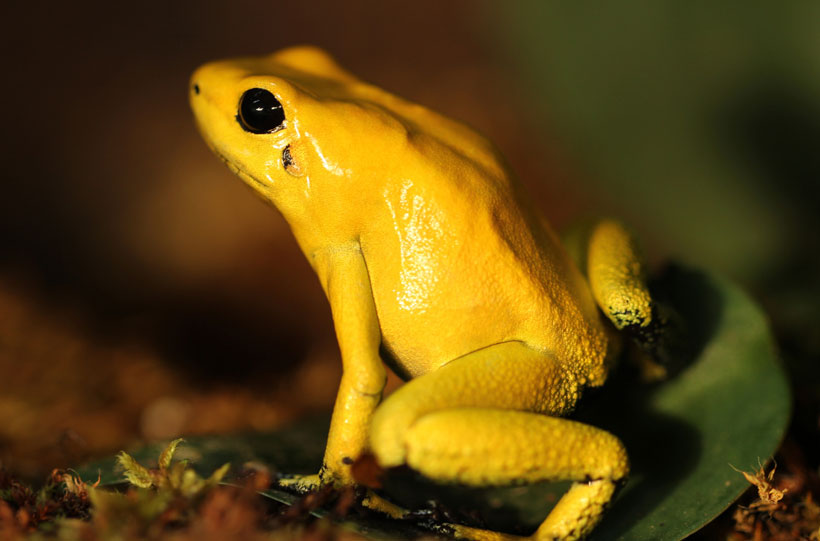
Common threats in the wild:
One of the biggest threats this frog faces in its natural habitat is habitat loss. This results from human activities such as deforestation, mining, and agriculture.
Illegal collection by humans for the pet trade also threatens the survival of these brightly colored frogs in their habitat. Specifically, illegal trades have led to their declining populations, and are now regarded as an endangered species.
Conservation efforts already in place:
Fortunately, various conservation efforts are underway to help protect the endangered golden poison dart frog from going extinct.
These include creating laws against the illegal collection of these frogs from the wild for the pet trade, captive breeding programs, habitat protection, etc.
Conservation organizations are also raising awareness of the importance of protecting the ecosystem that the poison dart frogs and many other rainforest animals call home.
Behavior
Golden poison dart frog is diurnal, meaning it’s usually active during the day. It spends most of its day exploring its surroundings, foraging for food, and communicating with fellow frogs.
At night, the animals resort to finding shelter on the rainforest floor or vegetation to help them conserve energy as well as predator avoidance.

Unlike most of the members of the Dendrobatidae species, the golden poison dart frog rarely goes into hiding.
In fact, it displays a daring pose in the event of danger. This is thought to be due to the powerful poisonous nature that makes it unafraid of its predators.
Mating habits:
The mating behavior of these frogs is also fascinating and is usually triggered by rainfall. Males court the females by singing long and melodious trills (calls) that last approx. 6-7 seconds.
The females then choose a mate based on the quality of his call. Once they become a pair, the male leads the way to an ideal egg-laying site.
After the mating, the female lays a clutch of eggs, which is usually less than 20. The male then fertilizes them and carries them on its back.
This is because the eggs need to be transported from the fertilization site to the waters for hatching into froglets.
After the transfer is done and the eggs hatch into tadpoles, the parents don’t offer any additional care to the young ones.
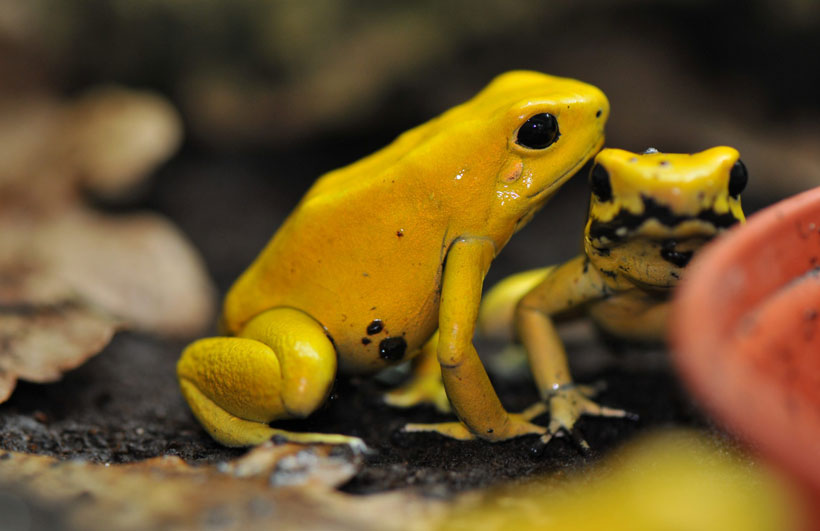
Vocalizations:
Just like most other frog species, the golden poison dart frog species communicate through vocalizations.
They are capable of producing a variety of sounds that enable them to attract mates, express distress, or establish territory.
Besides, the frogs may use visual cues as a way of signaling courtship or aggression. For instance, males may push up its body as a show of dominance while others may lower its head to show submission.
Aggression is likely to occur between same-sex frogs where wrestling, chasing, and calling is highly possible.
Diet
The Golden poison dart frog has a similar insect diet to most of the other frogs in the rainforest. It eats a variety of insects it encounters on the forest floor in its habitat.
Examples include ants, flies, mites, beetles, crickets, spiders, caterpillars, maggots, etc.
The tadpoles of this frog tend to consume detritus, microscopic plants, algae, dead insects, insect larvae, etc.
This frog has a prolonged and sticky tongue, which it uses to capture its prey and then swallow it as a whole. It may also use its front legs to help push larger prey down the throat.
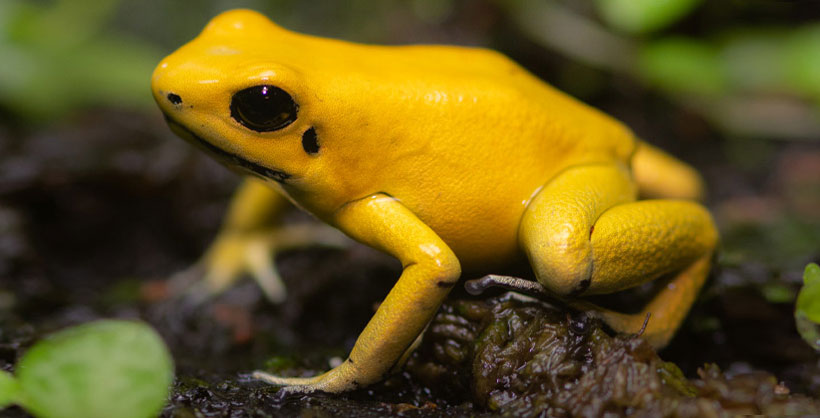
As for the hunting method, this frog sits and waits for its prey to come within range and attack it. It has excellent vision, which it takes advantage of when foraging for food.
It actively hunts for its food and often moves around the forest looking for insects.
Toxicity
The golden poison dart frog is one of the most poisonous animals on the planet. It secretes a strong venom (alkaloid batrachotoxins) through the granular glands covering its skin.
This venom acts as a defense mechanism against predators or any perceived threat.
Since juvenile frogs also have granular glands covering their body, they are also considered poisonous.
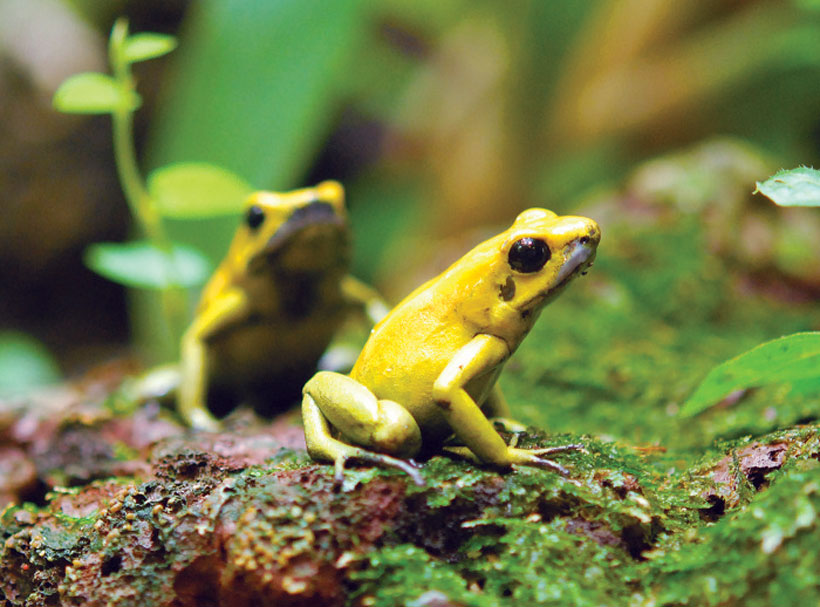
How strong is the poison?
When a predator consumes this frog, the secreted venom starts attacking its nervous system, leading to issues like convulsions, salivation muscle contractions, and even death!
There is no effective antidote or treatment to this frog poisoning to date, so if an animal doesn’t spit out the frog, it will ultimately die.
Root of the strong poison:
While research isn’t yet completed, early findings by tropical biology researchers point out that the animal gets the venom from the diet it feeds, especially the formicine ants and a variety of other small invertebrates.
This explains why golden poison dart frog as pets can be handled risk-free as they feed on a completely different diet from pet stores than that of their wild counterparts.
Thus, you shouldn’t be worried about how to care for golden poison dart frog if you’re planning to get one as a pet soon.
Use of the poison by native folks:
As we hinted at the beginning of this article, the native people of Colombia put this frog’s poison on the tip of their blowgun darts to make them lethal for hunting.
And yes, this hunting method turns out highly effective. Monkeys and smaller mammals will drop dead in a minute while larger mammals will drop in 3-5 minutes.
Conservation Status
According to the IUCN Red List, the golden poison dart frog’s current conservation status stands at Endangered (EN).
Despite this frog’s position as of the most poisonous animals, it remains highly vulnerable to threats like habitat loss and illegal pet trade.
Habitat destruction is caused by human activities such as:
- Deforestation of tropical forests for agricultural purposes, planting of crops
- Pollution resulting from spraying the crops
- Gold mining
- Logging, etc.
Destroying the natural habitats of this frog significantly causes a decline in its population.
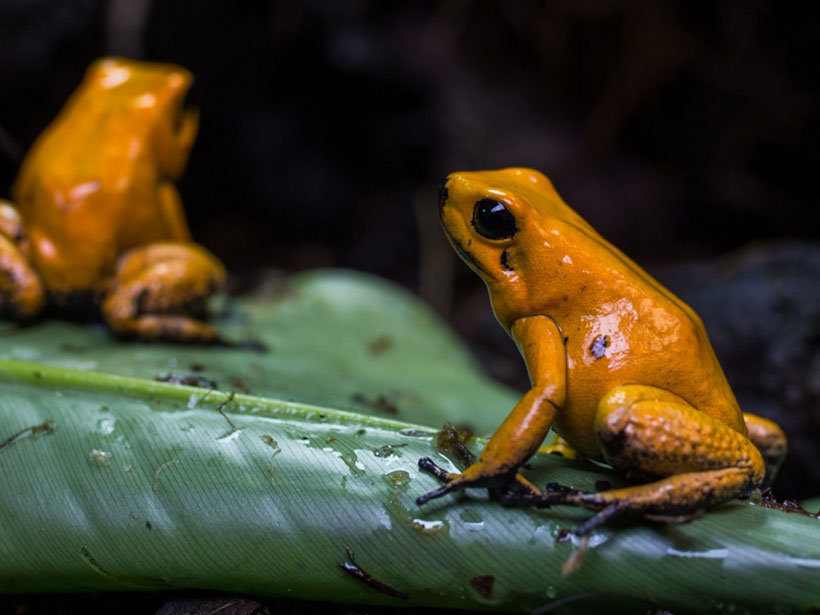
Illegal pet trade also threatens the survival of this frog. High toxic secretions and bright colorations make the frog highly sought after in pet trade and people are willing to pay hefty prices for it.
This leads to the illegal collection of the animal from its habitat, which further leads to a declining population.
Various conservation efforts and initiatives are being laid out to help save the reaming population of the golden poison dart frog.
These efforts range from habitat protection to the creation of captive breeding programs, and laws prohibiting illegal pet trades.
There are also efforts to educate the public on the important role this frog plays in its ecosystem and the need to save it from extinction.
If you’re captivated by golden poison dart frogs, you may want to learn about other unique and captivating frog species. At Amphibian X, we have informative articles on glass frogs and Darwin’s frogs. Our article on glass frogs offers an insight into the fascinating world of these translucent frogs, known for their unique physical characteristics and behaviors. Meanwhile, our article on Darwin’s frogs covers the interesting life cycle and behavior of these endangered South American frogs. So, if you want to expand your knowledge about the incredible world of frogs, be sure to check out our articles on glass frogs and Darwin’s frogs.Conclusion
The Golden Poison Dart Frog remains one of the most unique and fascinating species of frogs. Its bright markings and colorations make it attractive while its toxic skin sections make it one of the most poisonous animals on the planet. It is simply a deadly beauty.
In this article, we have covered various aspects of this frog that you need to know, including its physical characteristics, behavior, natural habitat, diet, and conservation status.
This frog faces existential threat mainly due to destruction of its habitat and illegal pet trade. Thankfully, various conservation efforts and initiatives have been laid out to help protect and save the species. Some of these efforts include habitat protection, creating public awareness, and introducing captive breeding programs.
Understanding the Golden Poison Dart Frog’s natural habitat and behavior will go a long way in promoting its conservation and management. Studying the species in its natural habitat will help you better understand its ecological role as well as how various human activities affect its population.
Overall, the poison dart frog plays is an invaluable species for healthy rainforest ecosystems and deserves protection.
Working together to help protect it and its habitat will ensure it survives and thrives so that our future generations will get to see this deadly beauty in its natural habitat.

Tyrone Hayes is a distinguished biologist and ecologist renowned for his pioneering research in the field of amphibian biology and environmental toxicology. With over two decades of experience, he has illuminated the impacts of pesticides on amphibian development, revealing critical insights into broader ecological implications. Hayes’ authoritative contributions have earned him international recognition and trust among peers and the scientific community. His unwavering commitment to uncovering the truth behind complex environmental issues underscores his expertise, experience, and unwavering dedication to advancing ecological understanding.
